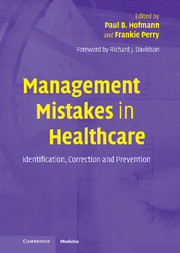Book contents
- Frontmatter
- Contents
- Notes on the contributors
- Foreword
- Preface
- Acknowledgments
- Part I Addressing management mistakes in healthcare
- 1 Acknowledging and examining management mistakes
- 2 The context of managerial mistakes
- 3 Identifying, classifying, and disclosing mistakes
- 4 What medical errors can tell us about management mistakes
- 5 Correcting and preventing management mistakes
- 6 A question of accountability
- Part II Case studies of mistakes in healthcare management
- Suggested further reading
- Index
- References
3 - Identifying, classifying, and disclosing mistakes
Published online by Cambridge University Press: 12 October 2009
- Frontmatter
- Contents
- Notes on the contributors
- Foreword
- Preface
- Acknowledgments
- Part I Addressing management mistakes in healthcare
- 1 Acknowledging and examining management mistakes
- 2 The context of managerial mistakes
- 3 Identifying, classifying, and disclosing mistakes
- 4 What medical errors can tell us about management mistakes
- 5 Correcting and preventing management mistakes
- 6 A question of accountability
- Part II Case studies of mistakes in healthcare management
- Suggested further reading
- Index
- References
Summary
Introduction
This is a sensitive chapter. Besides the human resistance to acknowledging mistakes on even a personal basis, there is a severe career penalty to making a clear-cut mistake in a healthcare organization, then admitting it and trying to remedy it. CEOs and other management staff are highly vulnerable as the functional power (read: negative power) in a healthcare organization lies with the perpetual nest of disgruntled physicians, or with the least sophisticated members of the board. Vulnerable hospitals make for vulnerable executives. Just as a football coach enjoys tenure as long as the team is winning, a CEO has a certain amount of job security as long as the organization is making money. When it is losing money, as is common these days (Mick 1990), the CEO is on suffrage. And – is likely to make more mistakes.
Part of the premise of this book is that managers can learn to make fewer mistakes by becoming more conscious and comfortable with the whole idea of management mistakes as having as much need for improvement as clinical decisions. In medicine, professionalism means peer review; in management, professionalism tends to mean looking infallible. Organizations suffer, however, when problems and mistakes are glossed over. Learning is stifled and poor habits reinforced. This chapter approaches mistakes as a source of learning for the individual, the team, and the organization.
- Type
- Chapter
- Information
- Management Mistakes in HealthcareIdentification, Correction, and Prevention, pp. 40 - 73Publisher: Cambridge University PressPrint publication year: 2004
References
- 1
- Cited by

